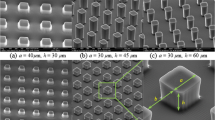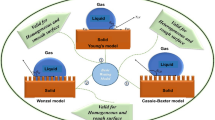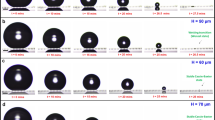Abstract
The hydrophobicity of natural surfaces has drawn much attention of scientific communities in recent years. By mimicking natural surfaces, the manufactured biomimetic hydrophobic surfaces have been widely applied to green technologies such as self-cleaning surfaces. Although the theories for wetting and hydrophobicity have been developed, the mechanism of wetting transitions between heterogeneous wetting state and homogeneous wetting state is still not fully clarified. As understanding of wetting transitions is crucial for manufacturing a biomimetic superhydrophobic surface, more fundamental discussions in this area should be carried out. In the present work, the wetting transitions are numerically studied using a phase field lattice Boltzmann approach with large density ratio, which should be helpful in understanding the mechanism of wetting transitions. The dynamic wetting transition processes between Cassie-Baxter state and Wenzel state are presented, and the energy barrier and the gravity effect on transition are discussed. It is found that the two wetting transition processes are irreversible for specific inherent contact angles and have different transition routes, the energy barrier exists on an ideally patterned surface and the gravity can be crucial to overcome the energy barrier and trigger the transition.
Similar content being viewed by others
References
Sefiane K. On the formation of regular patterns from drying droplets and their potential use for bio-medical applications. Journal of Bionic Engineering, 2010, 7, S82–S93.
Fang Y, Sun G, Cong Q, Chen G H, Ren L Q. Effects of methanol on wettability of the non-smooth surface on butterfly wing. Journal of Bionic Engineering, 2008, 5, 127–133.
Lai H, Ma C. The lattice Boltzmann model for the second- order Benjamin-Ono equations. Journal of Statistical Mechanics: Theory and Experiment, 2010, P04011.
Latt J, Chopard B. Lattice Boltzmann method with regularized pre-collision distribution functions. Mathematics and Computers in Simulation, 2006, 72, 165–168.
Yan Y Y, Gao N, Barthlott W. Mimicking natural superhydrophobic surfaces and grasping the wetting process: A review on recent progress in preparing superhydrophobic surfaces. Advances in Colloid and Interface Science, 2011, 169, 80–105.
Bormashenko E. Wetting transitions on biomimetic surfaces. Philosophical Transactions of the Royal Society of London A: Mathematical, Physical and Engineering Sciences, 2010, 368, 4695–4711.
Byun D, Hong J, Saputra, Ko J H, Lee Y J, Park H C, Byun B K, Lukes J R. Wetting characteristics of insect wing surfaces. Journal of Bionic Engineering, 2009, 6, 63–70.
Wong T S, Huang A P H, Ho C M. Wetting behaviors of individual nanostructures. Langmuir, 2009, 25, 6599–6603.
Grunau D, Chen S, Eggert K. A lattice Boltzmann model for multiphase fluid flows. Physics of Fluids A: Fluid Dynamics, 1993, 5, 2557–2562.
Gunstensen A K, Rothman D H, Zaleski S, Zanetti G. Lattice Boltzmann model of immiscible fluids. Physical Review A, 1991, 43, 4320–4327.
Li W, Amirfazli A. Hierarchical structures for natural superhydrophobic surfaces. Soft Matter, 2008, 4, 462–466.
Shi B, Guo Z. Lattice Boltzmann model for nonlinear convection- diffusion equations. Physical Review E, 2009, 79, 016701.
Nakajima A. Design of hydrophobic surfaces for liquid droplet control. NPG Asia Materials, 2011, 3, 49–56.
Wong T S, Sun T, Feng L, Aizenberg J. Interfacial materials with special wettability. MRS Bulletin, 2013, 38, 366–371.
Joseph P, Cottin-Bizonne C, Benoit J M, Ybert C, Journet C, Tabeling P, Bocquet, L. Slippage of water past superhydrophobic carbon nanotube forests in microchannels. Physical Review Letters, 2006, 97, 156104.
Lafuma A, Quéré D. Superhydrophobic states. Nature Materials, 2003, 2, 457–460.
Reis T, Phillips T N. Lattice Boltzmann model for simulating immiscible two-phase flows. Journal of Physics A: Mathematical and Theoretical, 2007, 40, 4033–4053.
Liu H, Valocchi A J, Kang Q. Three-dimensional lattice Boltzmann model for immiscible two-phase flow simulations. Physical Review E, 2012, 85, 046309.
Falcucci G, Bella G, Shiatti G, Chibbaro S, Sbragaglia M, Succi S. Lattice Boltzmann models with mid-range interactions. Communications in Computational Physics, 2007, 2, 1071–1084.
Bormashenko E Y. Wetting of real surfaces. Walter de Gruyter, 2013, 44, 406–409.
Li Q, Luo K, Li X J. Lattice Boltzmann modeling of multiphase flows at large density ratio with an improved pseudopotential model. Physical Review E, 2013, 87, 053301.
Inamuro T, Ogata T, Tajima S, Konishi N. A lattice Boltzmann method for incompressible two-phase flows with large density differences. Journal of Computational Physics, 2004, 198, 628–644.
Gao N, Yan Y. Modeling superhydrophobic contact angles and wetting transition. Journal of Bionic Engineering, 2009, 6, 335–340.
Zu Y, Yan Y. Single droplet on micro square-post patterned surfaces-theoretical model and numerical simulation. Scientific Reports, 2016, 6, 19281.
Gong W, Zu Y, Chen S, Yan Y. Wetting transition energy curves for a droplet on a square-post patterned surface. Science Bulletin, 2017, 62, 136–142.
Lee T, Liu L. Lattice Boltzmann simulations of micron-scale drop impact on dry surfaces. Journal of Computational Physics, 2010, 229, 8045–8063.
Lee T, Lin C L. A stable discretization of the lattice Boltzmann equation for simulation of incompressible two-phase flows at high density ratio. Journal of Computational Physics, 2005, 206, 16–47.
Yan Y Y, Zu Y Q, Dong B. LBM, a useful tool for mesoscale modelling of single-phase and multiphase flow. Applied Thermal Engineering, 2011, 31, 649–655.
Dupuis A, Yeomans J. Modeling droplets on superhydrophobic surfaces: Equilibrium states and transitions. Langmuir, 2005, 21, 2624–2629.
Vrancken R J, Kusumaatmaja H, Hermans K, Prenen A M, Pierre-Louis O, Bastiaansen C W, Broer D J. Fully reversible transition from Wenzel to Cassie-Baxter states on corrugated superhydrophobic surfaces. Langmuir, 2009, 26, 3335–3341.
Kusumaatmaja H, Yeomans J. Modeling contact angle hysteresis on chemically patterned and superhydrophobic surfaces. Langmuir, 2007, 23, 6019–6032.
Kusumaatmaja H, Vrancken R, Bastiaansen C, Yeomans J. Anisotropic drop morphologies on corrugated surfaces. Langmuir, 2008, 24, 7299–7308.
Hyväluoma J, Timonen J. Impact states and energy dissipation in bouncing and non-bouncing droplets. Journal of Statistical Mechanics: Theory and Experiment, 2009, P06010.
Zhang J, Kwok D Y. Contact line and contact angle dynamics in superhydrophobic channels. Langmuir, 2006, 22, 4998–5004.
Huang J J, Shu C, Chew Y T. Lattice Boltzmann study of droplet motion inside a grooved channel. Physics of Fluids, 2009, 21, 022103.
Swift M R, Osborn W, Yeomans J. Lattice Boltzmann simulation of nonideal fluids. Physical Review Letters, 1995, 75, 830.
Pearce J, Giustini A, Stigliano R, Jack Hoopes P. Magnetic heating of nanoparticles: The importance of particle clustering to achieve therapeutic temperatures. Journal of Nanotechnology in Engineering and Medicine, 2013, 4, 110071–1100714.
Yan Y Y, Zu Y Q. A lattice Boltzmann method for incompressible two-phase flows on partial wetting surface with large density ratio. Journal of Computational Physics, 2007, 227, 763–775.
Briant A J, Wagner A J, Yeomans J M. Lattice Boltzmann simulations of contact line motion. I. Liquid-gas systems. Physical Review E: Statistical, Nonlinear, and Soft Matter Physics, 2004, 69, 031602.
Briant A J, Yeomans J M. Lattice Boltzmann simulations of contact line motion. II. Binary fluids. Physical Review E: Statistical, Nonlinear and Soft Matter Physics, 2004, 69, 031603.
Inamuro T, Ogata T, Tajima S, Konishi N. A lattice Boltzmann method for incompressible two-phase flows with large density differences. Journal of Computational Physics, 2004, 198, 628–644.
Zu Y Q, Yan Y Y. Lattice Boltzmann method for modelling droplets on chemically heterogeneous and microstructured surfaces with large liquid-gas density ratio. IMA Journal of Applied Mathematics, 2011, 76, 743–760.
Kim Y H, Choi W, Lee J S. Water droplet properties on periodically structured superhydrophobic surfaces: A lattice Boltzmann approach to multiphase flows with high water/air density ratio. Microfluidics and Nanofluidics, 2010, 10, 173–185.
Tanaka Y, Washio Y, Yoshino M, Hirata T. Numerical simulation of dynamic behavior of droplet on solid surface by the two-phase lattice Boltzmann method. Computers & Fluids, 2011, 40, 68–78.
Patankar N A. Transition between superhydrophobic states on rough surfaces. Langmuir, 2004, 20, 7097–7102.
Patankar N A. Consolidation of hydrophobic transition criteria by using an approximate energy minimization approach. Langmuir, 2010, 26, 8941–8945.
Bormashenko E. Progress in understanding wetting transitions on rough surfaces. Advances in Colloid and Interface Science, 2015, 222, 92–103.
He B, Patankar N A, Lee J. Multiple equilibrium droplet shapes and design criterion for rough hydrophobic surfaces. Langmuir, 2003, 19, 4999–5003.
Author information
Authors and Affiliations
Corresponding author
Rights and permissions
About this article
Cite this article
Gong, W., Yan, Y., Chen, S. et al. Numerical study of wetting transitions on biomimetic surfaces using a lattice Boltzmann approach with large density ratio. J Bionic Eng 14, 486–496 (2017). https://doi.org/10.1016/S1672-6529(16)60414-6
Published:
Issue Date:
DOI: https://doi.org/10.1016/S1672-6529(16)60414-6




